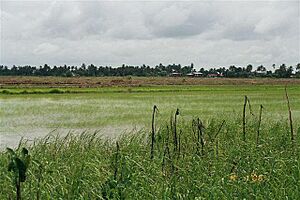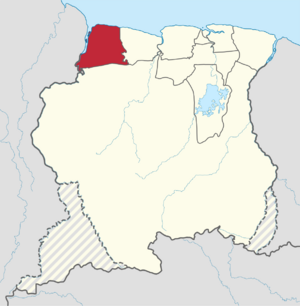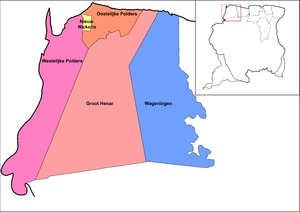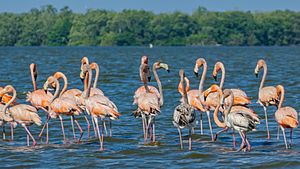Nickerie District facts for kids
Quick facts for kids
Nickerie
|
||
|---|---|---|
|
District
|
||

Rice fields in Nickerie
|
||
|
||

Map of Suriname showing Nickerie district
|
||
| Country | Suriname | |
| Capital | Nieuw-Nickerie | |
| Area | ||
| • Total | 5,353 km2 (2,067 sq mi) | |
| Population
(2012 census)
|
||
| • Total | 34,233 | |
| • Density | 6.3951/km2 (16.5632/sq mi) | |
| Time zone | UTC-3 | |
Nickerie is a cool district (a type of region) in Suriname, located on its northwest coast. Its capital city is Nieuw-Nickerie. Another important town there is Wageningen.
Nickerie touches the Atlantic Ocean in the north. To its east is the Coronie district of Suriname, and to the south is the Sipaliwini district. On its western side, it shares a border with the East Berbice-Corentyne region in Guyana.
In 2012, about 34,233 people lived in Nickerie. The district covers an area of 5,353 square kilometers. People from many different backgrounds live in Nickerie, including East Indian, Javanese, Afro-Surinamese, Chinese, and European people.
Nickerie is right next to Guyana. There isn't a bridge connecting the two countries. However, you can take a ferry that travels between Molson Creek in Guyana and South Drain in Nickerie.
Contents
History of Nickerie
Nickerie District was first settled by Amerindian people a very long time ago. Near the Wonotobo Falls, archaeologists found a settlement that dates back to the 1st century BC. This shows that people lived here over 2,000 years ago!
Between the 6th and 16th centuries, some special artificial mounds, called terpen, were built in the coastal area. The most famous of these is Hertenrits. In 1613, a tobacco farm was started near the Courantyne River, but it later disappeared.
Early Settlements and Plantations
In 1718, a person named Dietzel was the first to successfully settle in the Nickerie area. Later, in 1797, the governor Jurriaan François de Friderici approved the first large farm, called a plantation, in Nickerie.
During the time when the British controlled the area, many Scottish and English settlers arrived. They mostly grew cotton and coffee on their plantations. The current capital, Nieuw Nickerie, was built in 1879. This happened after the old district center, Nieuw Rotterdam, was destroyed by floods.
Origin of the Name
The name Nickerie likely comes from Neekeari. This name was first mentioned in 1596 by Teenstra, referring to an indigenous tribe living in the area. The name also appears in a book called The Voyage of Robert Dudley to the West-Indies, 1594-1595 by Robert Dudley.
Connecting Nickerie
For a long time, Nickerie had a poor connection to Paramaribo, the capital of Suriname. It wasn't until the 1960s that the East-West Link road was built. This road finally connected Nickerie with the rest of the country, making travel much easier.
Places to Visit in Nickerie
Nickerie has several interesting areas and towns. These are often called "resorts" in Suriname.
- Groot Henar
- Nieuw Nickerie
- Oostelijke Polders
- Wageningen
- Westelijke Polders
Villages in Nickerie
Besides the main towns, Nickerie is also home to several smaller villages:
- Cupido
- Glasgow
- Hamptoncourtpolder
- Lokono Shikuabana
- Manchester
- Paradise
- South Drain
Farming and Crops
In the 19th century, Nickerie was home to many large plantations. After slavery ended, the area changed to smaller farms. In the late 1800s, some farms started producing balatá, a type of latex used for belts and insulation. However, this became less popular in the early 1900s.
In 1955, a big project began to create more farmland by draining water from wet areas. This helped increase the amount of land that could be farmed.
Today, bananas and rice are the main crops grown in Nickerie. While some rice was grown before, Nickerie became the main center for rice farming in Suriname during the 20th century. This was largely thanks to the many East Indian and Javanese workers who came to the area.
Tourism and Nature
Nieuw Nickerie is becoming a popular spot for tourists. There are many hotels in the city. The nearby Bigi Pan Nature Reserve offers great chances for ecotourism, where people can enjoy nature.
In 1972, the Hertenrits Nature Reserve was created. This reserve has five of those special artificial mounds, or terpen, that were built long ago. These mounds are in the middle of a swamp, and ancient remains from the time before Christopher Columbus arrived were found there. Hertenrits has now become part of the larger Bigi Pan reserve.
See also
 In Spanish: Distrito de Nickerie para niños
In Spanish: Distrito de Nickerie para niños




